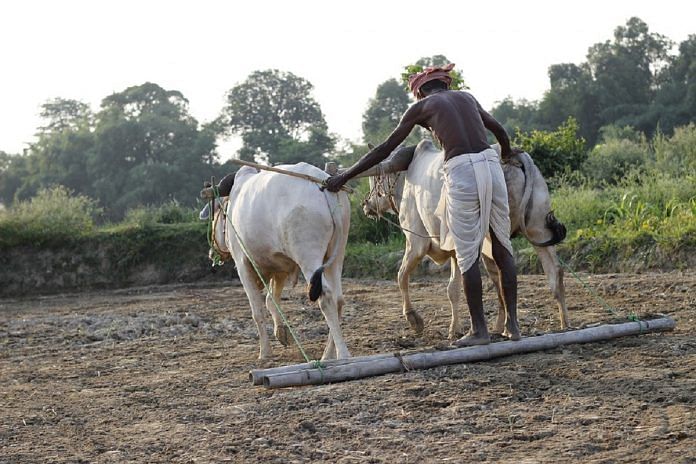The survey indicates that impact of climate change could be extremely high in un-irrigated areas if an adequate policy response is not brought in time.
New Delhi: At the World Economic Forum in Davos, well-known economist Joseph Stiglitz held forth rather favourably on the Indian economy but reserved his concern for the country’s agriculture sector.
“There is a lack of focus on environmental sustainability,” Stiglitz, a Nobel laureate, said in an interview to NDTV.
Days later, the Economic Survey echoed similar concerns. Volume 1 of the document dedicates a full chapter to climate change and agriculture and argues that temperature and rainfall changes in India could account for farm income losses of 15-18 per cent on average, rising to 20-25 per cent for un-irrigated areas in the coming years.
The survey warns that the impact of environmental and climatic changes could be extremely high in un-irrigated areas if an adequate policy response is not brought in time.
It also marks out the possible scale of the challenge — close to 52 per cent (73.2 million hectares area of 141.4 million hectares net sown area) — is still un-irrigated and rainfed.
So even as the volatility of agricultural growth in India has declined substantially — from a standard deviation of 6.3 per cent between 1960 and 2004 to 2.9 per cent since 2004 — it remains high compared to China, which has saved itself from the vagaries of weather. Close to 52 per cent area in India remains vulnerable to the same.
The heat is on
The survey places this in the context of the changing climatic conditions.
Between the 1970s and the past decade, kharif rainfall has declined on average by 26 mm and rabi rainfall by 33 mm. Annual average rainfall for this period has declined by about 86 mm on average.
In terms of temperature since 1970s, the average increase between the most recent decade and the 1970s is about 0.45 degrees and 0.63 degrees Celsius in the kharif and rabi seasons, respectively.
Temperature increases have been particularly felt in the northeast, Kerala, Tamil Nadu, Rajasthan and Gujarat. Some parts of India, for example Punjab, Odisha and Uttar Pradesh, have been the least affected though.
Then there is the pressing need to expand the reach of irrigation which has become increasingly challenging with groundwater levels depleting, the survey found.
In the 1960s, less than 20 per cent of agriculture was irrigated; today this number is in the mid-40s. The survey also points out how India pumps out more than twice as much groundwater as China or the United States with north India showing alarming levels of depletion.
It also cites an analysis of groundwater stations which reveals a 13 per cent decline in the water table over the past 30 years.
So while the Indo-Gangetic plain and parts of Gujarat and Madhya Pradesh are well irrigated; parts of Karnataka, Maharashtra, Madhya Pradesh, Rajasthan, Chhattisgarh and Jharkhand are still extremely vulnerable to climate change on account of not being well irrigated.
The impact
The Economic Survey notes that the impact of extreme temperature and rainfall ‘shocks’ are almost twice as high in un-irrigated areas compared with irrigated ones.
“The clear pattern that emerges is that crops grown in rainfed areas — pulses in both kharif and rabi — are vulnerable to weather shocks while the cereals — both rice and wheat — are relatively more immune,” it says.
Also, extreme temperature shocks reduce farmer incomes by 4.3 per cent and 4.1 per cent during kharif and rabi respectively, whereas extreme rainfall shocks reduce them by 13.7 per cent and 5.5 per cent.
In a year where temperature is 1 degree Celsius higher, farmer incomes would fall by 6.2 per cent during the kharif season and 6 per cent during rabi in un-irrigated districts.
Similarly, in a year when rainfall levels were 100 mm less than average, farmer incomes would fall by 15 per cent during kharif and by 7 per cent during the rabi season, the report says.
With climate change models projecting a 3-4 degree Celsius rise in temperature in India by the end of the 21st century, farm incomes could fall by 12 per cent on average in the coming years in the absence of any timely action.
The response
The Economic Survey prescribes some solutions. For instance, it talks about spreading out irrigation facilities with aggressive use of technologies of drip irrigation, sprinklers and water management.
Two, it stresses on investing in agricultural science and technology, especially for crops such as pulses and soyabean that are most vulnerable to weather and climate.
The survey advises supplementing this with effective insurance, topping up the existing Pradhan Mantri Fasal Bima Yojana.
It also advocates use of drone-like technology as used in Kenya to determine losses and compensate farmers within weeks.



